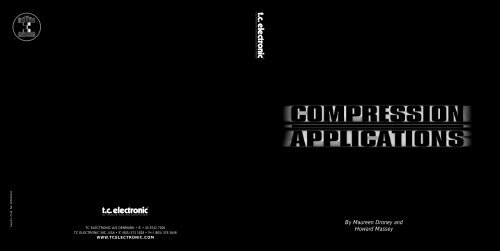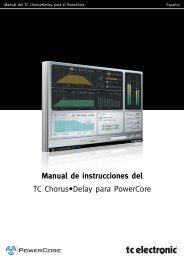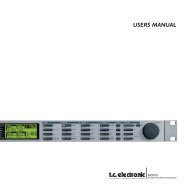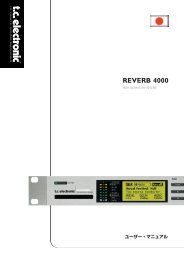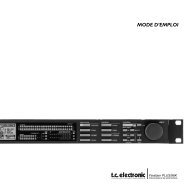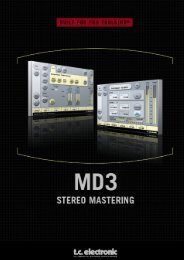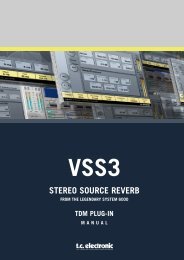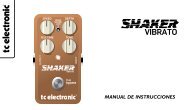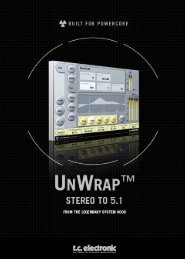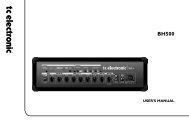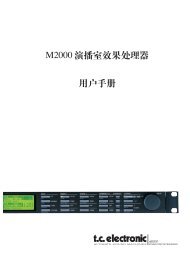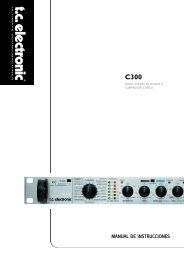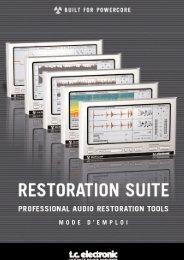Compression Applications A description of ... - TC Electronic
Compression Applications A description of ... - TC Electronic
Compression Applications A description of ... - TC Electronic
You also want an ePaper? Increase the reach of your titles
YUMPU automatically turns print PDFs into web optimized ePapers that Google loves.
Sep/01. Prod. No: 606005911<br />
<strong>TC</strong> ELECTRONIC A/S DENMARK • ✆ + 45 8742 7000<br />
<strong>TC</strong> ELECTRONIC INC. USA • ✆ (805) 373 1828 • [FAX] (805) 379 2648<br />
WWW.<strong>TC</strong>ELECTRONIC.COM<br />
By Maureen Droney and<br />
Howard Massey
THE <strong>TC</strong> ELECTRONIC GUIDE TO COMPRESSION AND LIMITING<br />
TABLE OF CONTENTS<br />
Part I: Introduction<br />
Introduction 4<br />
Why compress? 5<br />
Overload protection 5<br />
Gain consistency 6<br />
Increased loudness 7<br />
Part II: Controls & Features<br />
Input 8<br />
Threshold 8<br />
Ratio 8<br />
S<strong>of</strong>t Knee vs. Hard Knee 9<br />
Attack 9<br />
Release 9<br />
Output (Makeup Gain) 9<br />
Bypass 10<br />
Look-Ahead 10<br />
Sidechain Input 10<br />
Stereo Linking 10<br />
Full-Range vs. Multiband <strong>Compression</strong> 11<br />
Crossover (Multiband compression) 11<br />
Envelope 11<br />
Part III: <strong>Compression</strong> <strong>Applications</strong><br />
I. Single Source Signals<br />
Vocals 12-13<br />
De-Essing 13<br />
Guitar 13<br />
Bass 14<br />
Drums 14<br />
Piano 15<br />
Organ 15<br />
II. Multiple Source Signals<br />
Stereo and Dual Mono Signals 16<br />
Overall Bus <strong>Compression</strong> 16-17<br />
Compressing the headphone Cue Mix 18<br />
Brickwall limiting with in-ear monitors 18<br />
Page 3
PART I: INTRODUCTION<br />
PART I: INTRODUCTION<br />
Introduction<br />
The most powerful weapon in the audio arsenal is<br />
<strong>of</strong>ten the most misunderstood. Frequently, it is also<br />
the most misused. We are talking, <strong>of</strong> course, about<br />
compression - the signal processing technique that<br />
alters the dynamic range <strong>of</strong> an audio signal so that<br />
the loudest passages are reduced in level relative<br />
to the s<strong>of</strong>test ones, making it easier to hear every<br />
nuance <strong>of</strong> the music. A compressor (or "limiter,"<br />
when acting more severely) automatically "rides<br />
gain" on a signal much like a recording engineer<br />
does by hand as he manually raises and lowers the<br />
faders <strong>of</strong> a mixing console.<br />
Properly applied compression tightens up mixes<br />
and makes for exciting, upfront vocals and the<br />
punchy bass and drums that are the foundation<br />
upon which great pop music is built. <strong>Compression</strong><br />
can also add coloration, making a signal warmer<br />
and fatter or brighter and edgier. It can even be a<br />
musical tool, enhancing sustain or providing a<br />
snappier attack to selected instruments or individual<br />
notes.<br />
On the flip side, you've no doubt already heard<br />
examples <strong>of</strong> poor applications <strong>of</strong> compression -<br />
whether you realize it or not. If a track is not compressed<br />
sufficiently, the result may be an indecipherable<br />
vocal with missing consonants or a bass<br />
line where only certain notes punch through and<br />
others are lost. A track that is overcompressed will<br />
stay pretty much at the same volume all the way<br />
through (making for a boring listening experience)<br />
or can result in obvious crunchiness in your TV<br />
speaker when a loud signal like a cymbal crash<br />
triggers a reduction in volume <strong>of</strong> the overall audio.<br />
Which isn't to say that too much compression is<br />
always a bad thing: One well-known producer/<br />
engineer typically records bass by compressing<br />
both the direct and the amplified signal individually.<br />
He then submixes the two signals to a bus and<br />
straps a third compressor across that bus, then<br />
returns the signal to the console before routing it<br />
out again in combination with the kick drum, applying<br />
a fourth compressor across the new combined<br />
signal. And this is an engineer that always places a<br />
stereo compressor across his mix bus - someone<br />
who also, he avows, even relies upon his mastering<br />
engineer to provide yet more compression. Sounds<br />
like overkill, right? But this is someone who has<br />
dozens <strong>of</strong> platinum records to his name.<br />
In the world <strong>of</strong> compression and limiting - as in all<br />
audio recording - it's your ears that determine proper<br />
usage, not a set <strong>of</strong> rules. Creative compression<br />
techniques can open up a world <strong>of</strong> effects, from<br />
that special snap on a snare drum to an over-thetop<br />
room sound, to the characteristic distortion that<br />
can only come from overdriving a dynamics<br />
processor. That's where the real art <strong>of</strong> compression<br />
comes in, with most pr<strong>of</strong>essional engineers developing<br />
their own pet applications, many <strong>of</strong> which we will<br />
share with you in these pages.<br />
Why Compress?<br />
The basic concept behind a compressor/limiter is<br />
relatively simple. It is a device in which gain is automatically<br />
adjusted in a predetermined ratio in<br />
response to changes in the input signal level: in<br />
other words, it keeps the volume up during s<strong>of</strong>ter<br />
sections and brings it down when the signal gets<br />
louder.<br />
While the terms compression and limiting are <strong>of</strong>ten<br />
used interchangeably, it is generally accepted that<br />
when this kind <strong>of</strong> dynamic processing occurs at<br />
ratios below 10:1 (that is, where a change <strong>of</strong> 10 dB<br />
or less in input signal level results in an overall<br />
change in output level <strong>of</strong> 1 dB) it is referred to as<br />
compression; when higher ratios are used, it is<br />
known as limiting.<br />
At lower ratios, compressors gradually reduce the<br />
dynamic content above a user-determined threshold<br />
level. At higher ratios, limiters abruptly prevent<br />
signals above the threshold level from exceeding a<br />
certain maximum value.<br />
In multitrack recording, dynamics processing<br />
(another term for compression and limiting, as well<br />
as expansion and gating, which produce the opposite<br />
effect) is generally applied either to individual<br />
instruments or small groups <strong>of</strong> instruments. In mastering,<br />
and for radio and television broadcast,<br />
entire songs are compressed. Either way, the<br />
reasons for using a compressor range from the<br />
necessary to the creative.<br />
Overload Protection<br />
The original purpose <strong>of</strong> compressor/limiters was to<br />
protect equipment from excessive signals. Particularly<br />
in radio broadcast, the final power-amplifying<br />
tube in a transmitter - a large and expensive piece<br />
<strong>of</strong> equipment - was at risk. Even today, despite the<br />
advent and proliferation <strong>of</strong> digital recording (which<br />
provides the blessing <strong>of</strong> noise-free, wide dynamic<br />
range) it's all too easy to generate undesired distortion<br />
by overloading tape or circuits with uncontrolled<br />
signals. Ironically, the inherent limitations <strong>of</strong><br />
digital technology make signal overloading even<br />
more <strong>of</strong> a problem, resulting in an especially harsh<br />
distortion known as clipping.<br />
Overload protection is even more important in live<br />
sound applications when onstage performers are<br />
using in-ear monitors. In such an environment, a<br />
sudden, uncontrollably loud signal can cause<br />
permanent hearing damage. Live sound engineers<br />
rely on severe limiting (<strong>of</strong>ten called "brick-wall"<br />
limiting) to quickly and automatically reduce the<br />
level <strong>of</strong> signals exceeding a certain threshold.<br />
Page 4<br />
Page 5
PART I: INTRODUCTION<br />
PART I: INTRODUCTION<br />
Gain Consistency<br />
As we have seen, a compressor acts like an automatic<br />
fader. It reduces the difference in volume, or<br />
gain, between the loudest and s<strong>of</strong>test parts <strong>of</strong> a<br />
performance, a function that is necessary for many<br />
practical reasons.<br />
The dynamic range <strong>of</strong> human hearing (that is, the<br />
difference between the very s<strong>of</strong>test passages we<br />
can discern and the very loudest ones we can tolerate)<br />
is considered to be approximately 120 dB.<br />
Many <strong>of</strong> today's digital recording media approach<br />
that kind <strong>of</strong> dynamic range. However, unless the listener<br />
is in a virtually noise-free environment, quiet<br />
passages <strong>of</strong> recorded music can be lost in the<br />
ambient noise floor <strong>of</strong> the listening area, which, in<br />
an average home, is 35 to 45 dB.<br />
Likewise, when program material with wide dynamic<br />
range is reproduced through a medium with narrow<br />
dynamic range, such as radio, much information<br />
is likely to be lost. Everyone has heard the ultimate<br />
combination <strong>of</strong> these problematic factors: listening<br />
to music broadcast over the radio while riding in a<br />
car with the windows open.<br />
To prevent these problems, compression is customarily<br />
used to reduce the dynamic range <strong>of</strong><br />
program material to a level appropriate for the<br />
environment in which it is to be heard, as well as for<br />
the medium through which it is to be reproduced.<br />
During recording, compression is customarily used<br />
to minimize the volume fluctuations that occur<br />
when a singer or instrumentalist performs with too<br />
great a dynamic range for the accompanying<br />
music. It can also help to balance out volume<br />
fluctuations within an instrument itself, when, as<br />
commonly occurs, certain notes <strong>of</strong> a bass guitar<br />
resonate more loudly than others, or when a trumpet<br />
plays louder in some registers than in others.<br />
Properly applied compression will make a performance<br />
sound more consistent throughout.<br />
Increased Loudness<br />
When dynamic range is reduced, the overall level<br />
<strong>of</strong> the material can be raised (made "hotter") without<br />
the concern that peak levels will cause distortion.<br />
This kind <strong>of</strong> "squeezing" also serves to raise<br />
up the quiet sections <strong>of</strong> the program. By increasing<br />
the ratio <strong>of</strong> average-to-peak levels, compression<br />
enables a signal to be made significantly louder<br />
while the overall peak level <strong>of</strong> the material is<br />
increased only minimally.<br />
This application is particularly desirable in music<br />
that is destined to be played on the radio and television,<br />
where the competitive advantage <strong>of</strong> having<br />
your song stand out by being louder than others is<br />
obvious.<br />
Increased loudness is also an important factor during<br />
recording, both to analog tape and to digital formats.<br />
When recording to analog tape, compression<br />
can help to raise the level <strong>of</strong> the signal being<br />
recorded to an optimum level above the noise floor<br />
<strong>of</strong> background tape hiss.<br />
When recording to a digital medium, compression<br />
can help ensure that the signal is encoded at the<br />
highest possible level, where more bits are being<br />
used so that better signal definition is achieved.<br />
Finalizer 96K<br />
Triple•C<br />
M5000<br />
System 6000<br />
Page 6<br />
Page 7
PART II: CONTROLS AND FEATURES<br />
PART II: CONTROLS AND FEATURES<br />
Input<br />
Sounds obvious, right? A knob that controls the<br />
amount <strong>of</strong> signal entering a device, an Input Level<br />
Control is found on most, but not all, signal processors.<br />
Its usage, however, is a bit more complicated<br />
in compression than in some other applications,<br />
because the amount <strong>of</strong> input directly affects<br />
the threshold at which a compressor/limiter begins<br />
to work. The actual structure <strong>of</strong> Input controls and<br />
where unity gain (i.e., no signal boost or attenuation)<br />
appears on the knob will vary among manufacturers;<br />
it's a good idea to look up what they recommend<br />
as a starting position. For example, the <strong>TC</strong><br />
<strong>Electronic</strong> Finalizer's Analog Input <strong>of</strong>fers gain up to<br />
+26 dB or attenuation to -6dB, while the Triple•C<br />
Input level knob ranges from -6 to +18 dB.<br />
Threshold<br />
Threshold is perhaps the most critical control <strong>of</strong><br />
any compressor. It sets the level at which a compressor<br />
starts to work. Below the threshold point,<br />
the volume <strong>of</strong> a signal is unchanged; above it, the<br />
volume is reduced. For example, if Threshold is set<br />
to 0 dB, input signals at or above 0 dB will be<br />
compressed, while those below 0 dB will be<br />
unaffected.<br />
The incoming signal may be detected one <strong>of</strong> two<br />
ways - either by viewing signal peaks or by RMS<br />
("Root Mean Square," a formula for detecting average<br />
signal level, much like our ears do). A compressor<br />
may <strong>of</strong>fer input detection by either means,<br />
or, like the <strong>TC</strong> <strong>Electronic</strong> Finalizer, Triple•C,<br />
M5000 and System 6000, it may allow a choice<br />
between the two. Generally, peak detection works<br />
best for applications where you are using a limiter<br />
to prevent signal overloads, while RMS detection<br />
works best when you are using a compressor to<br />
raise overall apparent level.<br />
Ratio<br />
The amount <strong>of</strong> increase in input signal (in decibels,<br />
or dB for short) required to cause a 1 dB increase<br />
in output is called the <strong>Compression</strong> Ratio. A ratio<br />
<strong>of</strong> 1:1 means that for every 1 dB <strong>of</strong> increase in<br />
input level, there is a 1 dB increase in output level;<br />
in other words, there is no compression being<br />
applied. But a ratio <strong>of</strong> 8:1 means that an 8 dB<br />
increase in input is required to produce only a 1 dB<br />
increase in output.<br />
A compressor's Threshold and Ratio controls work<br />
in tandem. At a lower threshold setting, lower level<br />
signals are compressed. However, when the ratio<br />
is set lower - for example, 2:1 - the compressor has<br />
less effect on the signal. Ratios <strong>of</strong> 10:1 and greater<br />
are generally considered to be limiting as opposed<br />
to compressing. At high ratios <strong>of</strong> 20:1 or higher<br />
(some limiters even <strong>of</strong>fer a theoretical infinite ratio<br />
<strong>of</strong> ∞:1), "brick wall" limiting kicks in - that is, any<br />
change in input, no matter how great, results in<br />
virtually no increase in output level.<br />
S<strong>of</strong>t Knee vs. Hard Knee<br />
A compressor's "Knee" is related to its Threshold<br />
control. The knee determines whether the compressor<br />
will reach the maximum selected amount <strong>of</strong><br />
gain reduction quickly or slowly. A gradual transition<br />
("S<strong>of</strong>t Knee") from no response to full gain reduction<br />
will provide a gentler, smoother sound, while a<br />
more rapid transition ("Hard Knee") will give an<br />
abrupt "slam" to the signal. Therefore, a s<strong>of</strong>t knee<br />
is generally preferred for most program material,<br />
although the hard knee's attack can be useful in<br />
peak limiting and special situations such as<br />
de-essing.<br />
The knee <strong>of</strong> most compressors is preset to either<br />
hard or s<strong>of</strong>t, but some manufacturers <strong>of</strong>fer the<br />
ability to choose between the two.<br />
Attack<br />
The key to the operation <strong>of</strong> any compressor is the<br />
setting <strong>of</strong> the Attack and Release times; these are<br />
the parameters which most affect how "tight" or<br />
how "open" the sound will be after compression.<br />
Once a signal has crossed the threshold, the<br />
attack time is the amount <strong>of</strong> time it takes for the<br />
gain <strong>of</strong> a signal to decrease by the amount specified<br />
by the ratio control.<br />
A fast attack kicks in immediately and catches transients,<br />
reducing their level and thus "s<strong>of</strong>tening" the<br />
sound. A slow attack time allows transient signals<br />
to pass the threshold unscathed before compression<br />
begins.<br />
Beware: If an attack time is too short, desirable<br />
initial transients may be lost, s<strong>of</strong>tening the sound in<br />
an unintended way, perhaps even clipping consonants<br />
on a singer's voice.<br />
Release<br />
The Release time is the time it takes for the signal<br />
to return to its initial (pre-gain reduction) level after<br />
it drops below the threshold point.<br />
If the release time is set too short for the program<br />
material, with too much gain being restored each<br />
time the signal falls below the threshold, "pumping"<br />
and "breathing" artifacts occur, due to the rapid<br />
rise <strong>of</strong> background noise as the gain is increased.<br />
If the release time is set too long, however, a loud<br />
section <strong>of</strong> the program may cause gain reduction<br />
that persists through a s<strong>of</strong>t section, making the s<strong>of</strong>t<br />
section inaudible.<br />
Output (Makeup Gain)<br />
Last in line is the Output Control, also known as<br />
"makeup gain" because it is used to make up for<br />
the gain reduction accomplished by the compressor.<br />
To make it easier to compare the result <strong>of</strong> the<br />
processing, the output control should be set to unity<br />
gain, so that the processed signal is raised to the<br />
point at which it matches the level <strong>of</strong> the unprocessed<br />
input signal (for example, if a signal is being<br />
reduced in level by approximately -6 dB, the output<br />
makeup gain should be set to +6 dB). Some compressors,<br />
such as the <strong>TC</strong> <strong>Electronic</strong> Finalizer, can<br />
Page 8<br />
Page 9
PART II: CONTROLS AND FEATURES<br />
PART II: CONTROLS AND FEATURES<br />
automatically calculate makeup gain as a function<br />
<strong>of</strong> the threshold and ratio settings.<br />
Bypass<br />
Don't neglect the humble Bypass function - it's a<br />
tool that will let your ears decide if you are actually<br />
improving the signal! A switch which routes the<br />
input directly to the output, Bypass allows for direct<br />
A/B comparison <strong>of</strong> the processed and unprocessed<br />
signal.<br />
Look-Ahead<br />
Some compressors feature a "Look Ahead" feature,<br />
where, by slightly delaying the audio signal, the<br />
compressor can respond to the incoming signal<br />
before it is heard, thus enabling it to react more<br />
quickly and accurately to changes in level. The<br />
look-ahead delay time is usually scaled automatically<br />
with the attack time, but on some compressors,<br />
such as the compression algorithm in the <strong>TC</strong><br />
<strong>Electronic</strong> System 6000, the delay time may be<br />
manually set by the user.<br />
Sidechain Input<br />
A Sidechain Input allows a compressor to respond<br />
to a signal other than the one that is actually being<br />
affected. Many compressors provide a sidechain<br />
insert that allows processing <strong>of</strong> the signal before it<br />
reaches the detector, a function useful for such frequency-sensitive<br />
functions as de-essing.<br />
When de-essing, the high frequencies are boosted<br />
on the sidechain input signal, while the low and mid<br />
frequencies are cut. The compressor's detector<br />
reacts to the excessive highs, reducing the gain <strong>of</strong><br />
that portion <strong>of</strong> the signal alone.<br />
The opposite reaction - "ducking", or automatically<br />
lowering the level <strong>of</strong> a signal - may also be achieved<br />
through use <strong>of</strong> a sidechain input. This technique is<br />
<strong>of</strong>ten used in radio and television commercials to<br />
lower the level <strong>of</strong> a music bed while the announcer<br />
is speaking. The voiceover track is sent to the<br />
sidechain input, with the threshold set low enough<br />
to respond each time the voice is heard, causing<br />
the music to duck while the voice is speaking.<br />
Stereo Linking<br />
Generally used on stereo instruments, background<br />
vocal pairs or stereo mixes, a Stereo Link function<br />
allows two channels to be run through a compressor<br />
with both channels affected in the same manner<br />
by one common set <strong>of</strong> controls. This keeps the<br />
levels <strong>of</strong> the two sides even, but avoids problems<br />
with center shifting in the stereo image that may<br />
occur if separate compressors are used on each<br />
side. Stereo linking may work either <strong>of</strong> two ways:<br />
the channel receiving the most gain reduction may<br />
determine the gain reduction for the other channel,<br />
or it may be possible to designate one channel to<br />
be a master and the other a slave.<br />
Full-Range Versus Multiband <strong>Compression</strong><br />
Traditional compressors operate over the entire frequency<br />
range <strong>of</strong> the incoming signal; that is, they<br />
respond to changes in input regardless <strong>of</strong> where in<br />
the frequency spectrum transients may be occurring.<br />
While there are certainly advantages to using<br />
such a circuit design (for example, when compressing<br />
a single source signal with a limited bandwidth,<br />
such as a snare or kick drum), more modern<br />
compressors - such as the <strong>TC</strong> System 6000,<br />
M5000, Triple•C, and Finalizer - <strong>of</strong>fer a more flexible<br />
approach known as Multiband <strong>Compression</strong>, which<br />
is better suited to signal with broad frequency range.<br />
Here, the incoming audio signal is split into several<br />
user-determined frequency areas so that compression<br />
can be applied selectively to each. For example,<br />
if you are compressing an overall mix, a multiband<br />
compressor allows you to control low-frequency<br />
transients (such as kick drum hits) without affecting<br />
midrange and low frequencies, thus avoiding<br />
"pumping" or "breathing" signal artifacts. Specific<br />
examples <strong>of</strong> using both full-range and multiband<br />
compressors are given in Part III <strong>of</strong> this booklet.<br />
Crossover (Multiband <strong>Compression</strong>)<br />
As described in the previous section, multiband<br />
compressors such as the <strong>TC</strong> <strong>Electronic</strong> Finalizer,<br />
Triple•C, M 5000, and System 6000 make it possible<br />
to optimize dynamics separately over different<br />
frequency areas. Multiband compression avoids<br />
many <strong>of</strong> the problems inherent with traditional compression,<br />
such as the loss <strong>of</strong> high frequencies in<br />
compressed vocals.<br />
The Crossover Control in multiband compressors<br />
allows the user to define the lower and upper limit<br />
<strong>of</strong> each <strong>of</strong> the frequency bands, allowing compression<br />
to be applied only to the necessary areas, and<br />
different compression parameters to be applied to<br />
different frequency bands. The crossover points<br />
must be selected carefully while closely listening to<br />
the program material, since even slight changes<br />
can alter the sound dramatically.<br />
Envelope<br />
The <strong>TC</strong> Triple•C compressor <strong>of</strong>fers a special mode<br />
not found in any other compressor, called Envelope<br />
Mode. Here, the actual shape <strong>of</strong> the incoming signal<br />
can be altered by changing its level at the attack<br />
and release points. When the signal crosses the<br />
user-defined threshold, it is boosted or attenuated<br />
to the level defined by the Envelope Attack Gain<br />
parameter and then returns to the threshold level at<br />
a user-defined attack time. After the signal drops<br />
below the threshold level, a release parameter<br />
determines the amount <strong>of</strong> time it takes for the signal<br />
to decay before being boosted by the Envelope<br />
Release Gain parameter. Envelope mode is useful<br />
if you want to increase the apparent sustain <strong>of</strong> a<br />
sound or otherwise significantly alter its sonic<br />
characteristics (i.e., to create a more aggressive<br />
snare drum by boosting its attack level or to s<strong>of</strong>ten<br />
the hard transients <strong>of</strong> an acoustic piano or electric<br />
guitar).<br />
Page 10<br />
Page 11
PART III: COMPRESSION APPLICATIONS<br />
PART III: COMPRESSION APPLICATIONS<br />
In this section, we'll examine specific applications<br />
for dynamics processing. <strong>Compression</strong> and/or limiting<br />
can be applied to either single source signals<br />
(i.e. from individual live microphones or individual<br />
recorded tracks) or to multiple source signals (i.e.<br />
from submix buses or an overall stereo or surround<br />
mix). Let's look at each in turn.<br />
I. SINGLE SOURCE SIGNALS<br />
Vocals<br />
Perhaps the most common application <strong>of</strong> compression<br />
to single source signals is to vocals, primarily<br />
because the human voice has an unusually wide<br />
dynamic range. Trained opera singers, for example,<br />
have been known to shatter glass at a few paces!<br />
Full-range compressors tend to work well on<br />
vocals, since they do a good job <strong>of</strong> preserving legibility<br />
and articulation. However, multiband compression<br />
is sometimes preferable, especially if you<br />
want to control specific midrange transients that<br />
might otherwise trigger unwanted gain reduction <strong>of</strong><br />
higher frequencies.<br />
In live performance, Front <strong>of</strong> House (FOH) engineers<br />
almost always strap full-range compressors across<br />
vocal channels in order to maintain a consistent level<br />
even when the performer moves <strong>of</strong>f-mic and to<br />
ensure that whispered and s<strong>of</strong>tly sung words are<br />
heard clearly while loud, shouted passages do not<br />
overload power amplifiers and PA speakers. In<br />
these cases, fairly low thresholds are set (<strong>of</strong>ten<br />
resulting in 10 dB or more <strong>of</strong> gain reduction)<br />
in conjunction with high ratios <strong>of</strong> 8:1 or greater. In<br />
order to maintain legibility, moderately slow attacks<br />
(5 - 25 ms) are used to allow transients (such as<br />
consonants at the beginnings <strong>of</strong> words) to pass<br />
through unscathed; release times are set to be as<br />
short as possible without pumping artifacts (typically,<br />
around 100 ms). Backing vocals are <strong>of</strong>ten<br />
submixed and compressors applied across the<br />
bus, with similar settings.<br />
In the studio, vocal compression can be used much<br />
more subtly, especially if the singer has a trained<br />
voice and good mic technique. When recording<br />
vocals, ratios are generally 4:1 or less (sometimes<br />
as low as 1.5:1), with thresholds set so that there<br />
is only 3 - 6 dB <strong>of</strong> gain reduction on average. As<br />
with live performance, attack times must be sufficiently<br />
slow as to allow the beginnings <strong>of</strong> words to<br />
pass, with release times long enough to avoid obvious<br />
pumping (however, shorter attack and release<br />
times can be used to create a breathy "in-yourface"<br />
vocal effect). During mixdown, when there is<br />
more control, multiband compressors set to higher<br />
ratios <strong>of</strong> 6:1 or greater are <strong>of</strong>ten used to tame lead<br />
vocals, particularly when they need to sit in a dense<br />
bed <strong>of</strong> instrumentation. Mix engineers <strong>of</strong>ten apply<br />
different compression amounts to different passages<br />
(i.e., a s<strong>of</strong>tly sung verse may receive more compression<br />
than an aggressively sung chorus) or even<br />
to individual words. Backing vocal tracks are generally<br />
submixed in mono or stereo (see the "Stereo<br />
Signals" section below for more information on the<br />
latter), with more severe degrees <strong>of</strong> compression<br />
(i.e., lower thresholds, higher ratios, and shorter<br />
attack and release times) typically applied.<br />
Another common vocal compression trick used<br />
during mixdown is to mult a vocal track so that it<br />
appears on two faders, severely compress one <strong>of</strong><br />
the two, and then carefully mix the two signals<br />
together. This serves to preserve much <strong>of</strong> the original<br />
dynamic range while allowing s<strong>of</strong>tly sung<br />
sections to cut through more clearly.<br />
De-Essing<br />
Sibilance in a voice - those nasty bits <strong>of</strong> distortion<br />
caused by too much <strong>of</strong> the letter "s" (as well as<br />
fricatives like "f" and "t") - can be selectively reduced<br />
by the use <strong>of</strong> a de-esser. This is a frequencydependent<br />
compressor that utilizes a filter in the<br />
input signal circuit (or in a sidechain circuit) so that<br />
compression is triggered when an excess <strong>of</strong> high<br />
frequency signal is detected. Multiband compressors<br />
are especially well-suited for this purpose;<br />
simply use the Crossover control to isolate the frequency<br />
band in which the <strong>of</strong>fending "esses" are<br />
occurring (typically 7 - 10 kHz) and then compress<br />
that frequency area only.<br />
Note that de-essers are normally patched before<br />
console and outboard equalizers so that some <strong>of</strong><br />
the high frequencies removed by the de-essing<br />
process can be restored, albeit without the<br />
distortion and radical increases in level that were<br />
originally present.<br />
Guitar<br />
There are, <strong>of</strong> course, many different kinds <strong>of</strong> guitars,<br />
ranging from the overdistorted electric lead sound<br />
<strong>of</strong> heavy metal, to the clean, crisp sound <strong>of</strong> a direct<br />
injected (DI) funk guitar, to the gentle strumming <strong>of</strong><br />
an acoustic guitar - but compression can aid in the<br />
sound <strong>of</strong> all <strong>of</strong> them.<br />
For a heavy rock guitar, try a full-range compressor<br />
with a severe limiting ratio <strong>of</strong> 10:1 or even 20:1,<br />
with a threshold that yields 6 - 10 dB <strong>of</strong> gain reduction<br />
and a sufficiently long attack time so that the<br />
transients <strong>of</strong> each chord or note are unaffected.<br />
Clean funk guitars benefit from the use <strong>of</strong> multiband<br />
compressors, with a ratio <strong>of</strong> 6:1 on the<br />
midrange frequencies and a lesser ratio (3:1 or<br />
4:1) on the high frequencies. Again sufficiently long<br />
attack times must be used so that the rising edge<br />
<strong>of</strong> each chord is clearly delineated. Steel-string<br />
acoustic guitars also benefit greatly from compression,<br />
either multiband or full-range, depending<br />
largely upon the quality <strong>of</strong> the guitar (a well-constructed<br />
instrument will yield a more consistent<br />
sound across all strings, and thus will work fine<br />
with a full-range compressor; a lower-quality guitar<br />
with apparent differences in level from string to<br />
string or even note to note will benefit from multiband<br />
compression). Here, gentler compression ratios <strong>of</strong><br />
1.5:1 or 2:1 are in order, with sparing use <strong>of</strong> the<br />
threshold control so that there is nominal gain<br />
reduction <strong>of</strong> 2 -3 dB; again, the attack time must be<br />
sufficiently long so as to not "s<strong>of</strong>ten" the sharp<br />
sound <strong>of</strong> the plectrum on the string.<br />
Page 12<br />
Page 13
PART III: COMPRESSION APPLICATIONS<br />
PART III: COMPRESSION APPLICATIONS<br />
Bass<br />
Because it is important that every bass note be<br />
heard clearly (and because few basses are constructed<br />
well enough to deliver each note at equal<br />
level, nor are there many bass players who have<br />
sufficiently good technique to deliver this), basses<br />
are almost always compressed; many engineers<br />
even double-compress them - once during recording<br />
and again during mixing.<br />
A typical starting setting for a full-range compressor<br />
affecting a rock bass would be to have a ratio<br />
<strong>of</strong> 3:1 or 4:1, with the threshold set to deliver 4 - 8<br />
dB <strong>of</strong> gain reduction for peak notes. Hard knee<br />
compression works well here. If the bass is played<br />
with a plectrum, the attack time can be fairly short<br />
so as to smooth out the start <strong>of</strong> notes; if played with<br />
the fingers (and especially if played funk-style), the<br />
attack time should be somewhat longer so that<br />
transients get through unscathed. Release time is<br />
particularly important with bass, and should be sufficiently<br />
long so as to impart smooth sustain to held<br />
notes.<br />
Multiband compressors work really well on bass,<br />
since they allow the lowest frequencies to be<br />
tightened up (reducing "wo<strong>of</strong>iness") without affecting<br />
the mid- and high-midrange frequencies, which<br />
carry the attack <strong>of</strong> the sound. When compressing<br />
low frequencies alone, you can use very fast attack<br />
times since the wavelengths are so long; however,<br />
for the same reason, you'll need to set very long<br />
release times.<br />
Drums<br />
Drums are usually recorded with multiple microphones<br />
and <strong>of</strong>ten submixed to a stereo pair during<br />
mixdown. Typically, separate microphones are<br />
used to capture the sound <strong>of</strong> the snare drum, kick<br />
drum, each <strong>of</strong> the tom-toms, and sometimes the<br />
high-hat. Most <strong>of</strong>ten, a pair <strong>of</strong> overhead mics is<br />
used to capture the cymbals (and add some "air" to<br />
the drum kit), and, depending upon the studio environment,<br />
room mics may be set up as well to add<br />
ambience.<br />
<strong>Compression</strong> is almost always applied to the snare<br />
and kick drum tracks so as to add "snap" to the<br />
signal and level out all the hits so that they are consistent<br />
throughout the song. Full-range compressors<br />
work fine for this purpose due to the limited<br />
frequency bandwidth <strong>of</strong> the snare and kick.<br />
Typical settings for snare drum compression are a<br />
ratio <strong>of</strong> 3:1, with a gain reduction <strong>of</strong> 4 - 8 dB and<br />
very fast attack (so as to "squash" the sound) and<br />
release times. The kick drum will have similar settings,<br />
but with slightly higher ratio (4:1 or 5:1) and<br />
a slightly lower threshold (set for gain reduction <strong>of</strong><br />
6 - 10 dB). S<strong>of</strong>t knee compression works best for<br />
both applications, and careful setting <strong>of</strong> the attack<br />
time is critical to achieve the effect you want. Tomtom<br />
tracks are also sometimes compressed, with<br />
similar settings.<br />
<strong>Compression</strong> is also typically applied to drum kit<br />
room ambience mics as an effect. Here, much higher<br />
limiting ratios (10:1 or even 20:1) are applied, with<br />
low thresholds (8 - 12 dB <strong>of</strong> gain reduction) and<br />
very slow attack and very fast release times so as<br />
to engender obvious pumping. When mixed in<br />
carefully with the close-miked tracks (and especially<br />
if the ambient tracks are sharply gated), this can<br />
serve to impart the huge "room" sound prevalent in<br />
many rock records.<br />
Piano<br />
The acoustic piano (short for "pian<strong>of</strong>orte," which literally<br />
means "s<strong>of</strong>t-loud") is capable <strong>of</strong> producing a<br />
staggeringly large dynamic range. This is one<br />
reason why it works so well as a solo instrument,<br />
and in classical or jazz recordings, piano is rarely<br />
compressed at all because the beauty in the music<br />
lies in the very dynamic range <strong>of</strong> the performance.<br />
However, in rock music, or wherever piano appears<br />
as an ensemble instrument, gentle compression<br />
can help balance out the sound, particularly when<br />
certain notes or chords jump out. Here, multiband<br />
compressors work extremely well because you can<br />
home in on the precise frequency area that needs to<br />
be tamed without affecting the rest <strong>of</strong> the range <strong>of</strong><br />
notes. Gentle ratios <strong>of</strong> 1.5:1 or 2:1 are <strong>of</strong>ten used<br />
(perhaps as much as 4:1 in rock music), with<br />
threshold set so that there is no more than 2 - 4 dB<br />
<strong>of</strong> gain reduction. The attack time is particularly<br />
critical since it is vital that the transients - the attack<br />
<strong>of</strong> the hammer on the strings - be preserved;<br />
usually it is set no faster than 50 msec.<br />
The release time also has to be carefully set so as<br />
to avoid pumping; however, where sustained notes<br />
are played, longer release times should be used.<br />
Organ<br />
Rock organ produces sustained notes with slow<br />
attacks, and compression can <strong>of</strong>ten help smooth<br />
out a performance, especially when the organist is<br />
not sufficiently schooled in the use <strong>of</strong> the volume<br />
pedal. Here, multiband compressors work best since<br />
they allow you to identify the particular frequency<br />
range that needs dynamic processing. High limiting<br />
ratios <strong>of</strong> 10:1 or 12:1 are <strong>of</strong>ten used, with low<br />
thresholds that result in 8 - 12 dB <strong>of</strong> gain reduction.<br />
Since there really is no transient in most organ<br />
sounds (other than when the percussion switch is<br />
engaged), short attack times <strong>of</strong> a millisecond or<br />
less work quite well; release times must be sufficiently<br />
long so as to provide sustain without audible<br />
pumping.<br />
If a multiband compressor is not available to you,<br />
you can try this trick: simply apply a full-range compressor<br />
to the microphone on the low Leslie<br />
speaker, and leave the other mic (which is picking<br />
up the rotating horn carrying the high frequencies)<br />
uncompressed. This will serve to effectively compress<br />
the low frequencies only, giving you the ability<br />
to tighten up the sound without altering the attack<br />
transients.<br />
Page 14<br />
Page 15
PART III: COMPRESSION APPLICATIONS<br />
PART III: COMPRESSION APPLICATIONS<br />
II. MULTIPLE SOURCE SIGNALS<br />
Stereo and Dual Mono Signals<br />
When compressing stereo signals (i.e., acoustic<br />
pianos recorded with two microphones, backing<br />
vocals panned across a stereo soundstage, or<br />
ambient tracks recorded with stereo mics), it is<br />
generally desirable that the stereo link switch on<br />
the compressor be engaged so that transients in<br />
one channel do not trigger gain reduction in the<br />
other channel, since this will result in audible<br />
"pumping" and "breathing" artifacts.<br />
When compressing dual mono signals, however,<br />
the stereo link switch can provide some interesting<br />
creative effects. One trick used by engineers back<br />
in the '60s was to route a mono backing track into<br />
one channel <strong>of</strong> a stereo compressor and then mult<br />
the lead vocal, using one mult to mix its level in with<br />
the backing track, and feeding the other mult into<br />
the input <strong>of</strong> other channel <strong>of</strong> the stereo compressor<br />
but without taking an output from that channel. The<br />
threshold <strong>of</strong> the lead vocal channel would be carefully<br />
set and the stereo link button engaged, so that<br />
whenever the vocalist was singing, the backing<br />
track would be slightly reduced in volume, allowing<br />
the vocal to better "sit."<br />
Another trick in a similar vein is to take both a bass<br />
DI (Direct Inject) signal and a miked bass amplifier<br />
and record each signal on a separate track. Then<br />
feed each into a channel <strong>of</strong> a stereo compressor<br />
and engage the stereo link switch. This way, on the<br />
notes where the DI signal, for example, might be<br />
louder than the bass amp signal, the compressor<br />
will control the level <strong>of</strong> both simultaneously.<br />
Interesting effects can also be created by compressing<br />
stereo reverb returns and/or sends. By<br />
using long attack and release times (with fairly<br />
severe ratios <strong>of</strong> 8:1 or greater), this will serve to lift<br />
the level <strong>of</strong> the reverb whenever the input signal<br />
starts to die away, making for an interesting<br />
(if unnatural) "in-your-face" sound.<br />
Overall Bus <strong>Compression</strong><br />
"<strong>Compression</strong> is the sound <strong>of</strong> rock," observes one<br />
multiplatinum engineer. Certainly it is the sound <strong>of</strong><br />
radio and television; virtually all broadcast facilities<br />
strap compressors or limiters across the final mix<br />
bus. Back in the days <strong>of</strong> vinyl, mastering engineers<br />
also typically applied compression to the overall<br />
signal so as to maximize level and tame transients<br />
that might cause the stylus to literally jump out <strong>of</strong><br />
the grooves.<br />
Today, in the era <strong>of</strong> the CD, such applications <strong>of</strong><br />
compression are no longer strictly required in a<br />
technical sense; however, record company marketing<br />
executives inevitably strive to produce the<br />
loudest recordings possible on the theory that<br />
louder not only sounds better but also better<br />
captures the attention <strong>of</strong> the listener. As a result,<br />
not only do mastering engineers continue to apply<br />
liberal doses <strong>of</strong> compression to the finished twotrack<br />
tapes or disks arriving at their facility, but<br />
mixing engineers <strong>of</strong>ten apply it beforehand,<br />
strapping a compressor across the stereo mix bus.<br />
In these kinds <strong>of</strong> applications, however, less is<br />
more, particularly since overcompression is difficult<br />
if not impossible to remove. Typical threshold<br />
settings are very low so that only 1 - 2 dB <strong>of</strong> gain<br />
reduction is occurring, and only when severe<br />
peaks occur. Ratios are also very gentle, in the<br />
1.5:1 to 2:1 range, with long attack and release<br />
times (50 msec or greater for the attack; 250 msec.<br />
or greater for the release) so as to avoid pumping.<br />
The advent <strong>of</strong> DVDs and multichannel audio means<br />
that there will be times when a multichannel compressor<br />
is required to affect all channels in a coherent<br />
way. The <strong>TC</strong> System 6000 <strong>of</strong>fers such an algorithm<br />
- the MD-5.1 - which is widely used by mixing<br />
and mastering engineers working in the rarified<br />
field <strong>of</strong> surround sound. This provides five discrete<br />
channels <strong>of</strong> 3-band compression as well as a fullrange<br />
brickwall limiter on all outputs, plus a separate<br />
LFE (Low Frequency Effects, or subwo<strong>of</strong>er)<br />
channel with full-range compression and limiting.<br />
Most significantly, three assignable sidechain link<br />
inputs for each <strong>of</strong> the five main channels allow<br />
selective and interactive compression <strong>of</strong> multiple<br />
sources without pumping artifacts. For example,<br />
the two rear and two front channels can be linked<br />
to one another, with the center channel responding<br />
to changes in level occurring from both center and<br />
front left and right feeds.<br />
Because surround sound enables the overall mix to<br />
be spread among six, as opposed to two, speakers,<br />
less compression (and equalization) is generally<br />
required than in traditional stereo mixes. <strong>Compression</strong><br />
ratios for surround signals are therefore<br />
generally very low - 2:1 or 3:1 - with long attack and<br />
release times and thresholds set so that there is<br />
rarely more than 3 - 5 dB <strong>of</strong> gain reduction.<br />
<strong>TC</strong> Icon - System 6000<br />
Page 16<br />
Page 17
PART III: COMPRESSION APPLICATIONS<br />
Compressing The Headphone Cue Mix<br />
When recording vocals, the objective is to get the<br />
singer to deliver as strong a performance as possible<br />
while still singing on pitch. To this end, the<br />
headphone cue mix is extremely important, and<br />
many singers prefer to hear the song in their<br />
headphones in as finished a state as possible. For<br />
this reason, many engineers opt to strap a compressor<br />
or limiter across the auxiliary send(s) feeding<br />
the headphone amplifier, <strong>of</strong>ten setting the threshold<br />
sufficiently low and release time sufficiently fast so<br />
as to impart an audible pumping, same as the track<br />
might sound when played on the radio. Some even<br />
use multiple dynamics processors for this purpose,<br />
strapping a mono compressor across the vocal<br />
track and a stereo limiter across the backing track<br />
which is triggered by a sidechain input from the<br />
vocal so as to impart a subtle "ducking" whenever<br />
the vocal enters. The bottom line, as one producer<br />
says: "Whatever the vocalist likes to hear that gets<br />
them to deliver a performance, that's what I give<br />
them."<br />
to quickly and automatically reduce the level <strong>of</strong><br />
signals exceeding a certain threshold. In such an<br />
application, the ratio is set as high as possible:<br />
10:1, 20:1, or even, if available, ∞:1 (infinity to<br />
one), with the threshold carefully set to a point well<br />
below that at which hearing damage can occur.<br />
The attack time is generally very fast so that highlevel<br />
transients cannot pass through unaffected,<br />
with the release time set according to the program<br />
material.<br />
Brickwall Limiting With In-Ear Monitors<br />
As noted in Part I <strong>of</strong> this booklet, the usage <strong>of</strong> inear<br />
monitors during live performance provides performers<br />
with an accurate, highly controllable<br />
means <strong>of</strong> hearing themselves without having to rely<br />
on onstage wedge speakers which are prone to<br />
feedback. However, an uncontrollably loud signal<br />
routed to an in-ear monitor can cause permanent<br />
hearing damage, so live sound engineers rely on<br />
severe limiting (<strong>of</strong>ten called "brick-wall" limiting)<br />
Page 18


